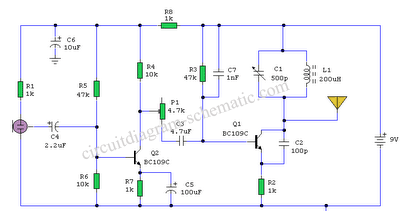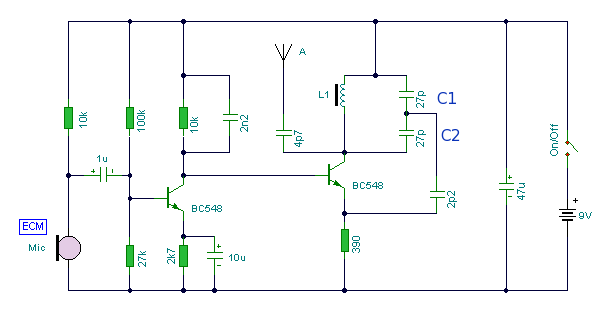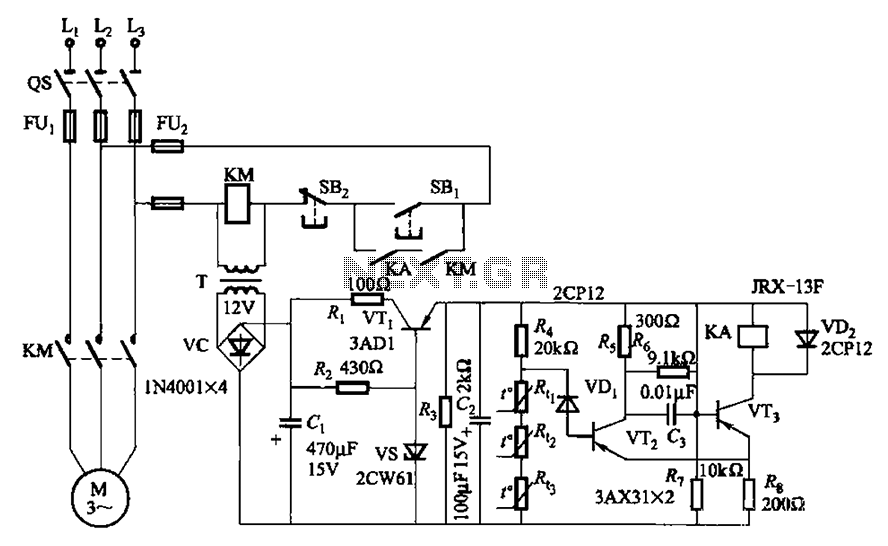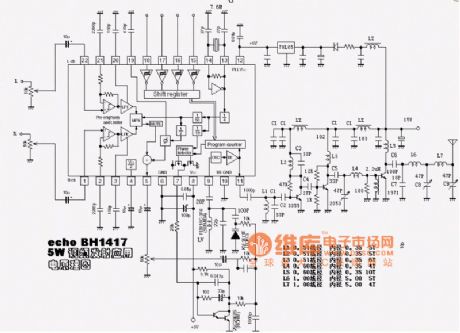
am transmitter circuits

The AM transmitter circuit consists of an audio amplifier and an RF oscillator. The oscillator is constructed around transistor Q1 and its associated components. The tank circuit, which includes inductor L1 and variable capacitor VC1, is tunable from approximately 500 kHz to 1600 kHz. These components can be sourced from an old medium wave (MW) radio if available. Q1 requires regenerative feedback to maintain oscillation, which is accomplished by connecting the base and collector of Q1 to opposite ends of the tank circuit. A 1nF capacitor, C7, facilitates the signal flow from the bottom to the top of L1, while capacitor C2, rated at 100 pF, ensures that oscillations are transferred from the collector to the emitter and back to the base through the internal base-emitter resistance of the transistor. Resistor R2 plays a crucial role in this configuration, preventing oscillations from being grounded through the low internal resistance at the emitter and enhancing the input impedance to avoid interference with the modulating signal. The oscillation frequency can be adjusted using VC1. The circuit also includes Q2, which functions as a common emitter amplifier, with capacitor C5 decoupling the emitter resistor to optimize performance. An electric condenser microphone serves as the audio input, and the level of AM modulation is controlled by a 4.7 kΩ preset resistor, P1. Although an antenna is not strictly necessary, a 30 cm length of wire connected to the collector can be utilized to extend the transmitter's range.
The AM transmitter circuit is designed for simplicity and effectiveness in transmitting audio signals over short distances. The core of the circuit is the RF oscillator, which utilizes Q1 to generate the carrier frequency. The regenerative feedback loop established by connecting the base and collector enhances the amplitude of oscillations, allowing for stable signal generation. The tank circuit, composed of L1 and VC1, defines the frequency of oscillation, which is adjustable to accommodate different transmission needs.
Capacitor C7 serves as a coupling element that ensures the oscillation signal is effectively transferred through the inductor L1, while C2's role in coupling the collector and emitter allows for efficient signal modulation. The careful selection of R2 is essential; it not only stabilizes the oscillation but also sets the input impedance to a level that minimizes distortion from the modulating audio signal.
Q2 amplifies the modulated signal, ensuring that the output is strong enough for transmission. The decoupling capacitor C5 is critical in maintaining signal integrity by isolating the power supply variations from the amplifier's performance. The use of an electric condenser microphone as the audio input provides high fidelity, making the circuit suitable for various audio applications.
The addition of a wire antenna can significantly enhance the transmission range, making this AM transmitter circuit a practical solution for short-range audio broadcasting applications. Overall, this circuit exemplifies a straightforward approach to AM transmission, utilizing readily available components and clear design principles.The AM Transmitter circuits in two and a half, audio amplifier and an RF oscillator. The oscillator is built around Q1 and associated components. Tank circuit L1 and VC1 is melodious from about 500kHz to 1600KHz. These components can be used from an old MW radio, if available. Needs Q1 regenerative feedback to oscillate and this is achieved by con necting the base and collector of Q1 to the opposite end of the tank circuit. 1nF capacitor C7, the signal pair from the bottom to the top of L1, and C2, 100pF ensures that the oscillation is passed from collector to emitter, and through the internal base emitter resistance of transistors, back to base again. R2 has an important role in this series. Ensure that the oscillations will not be pushed to the ground through the emitter is very low internal resistance, returning from Q1, and also increases the input impedance so that the modulating signal will not be encouraged.
Oscillation frequency is adjusted with VC1. The following is a schematic drawing: Q2 is the cable as a common emitter amplifier, C5 decoupling the emitter resistor and realize the full benefits of this phase. Electric condenser microphone is mic and the amount of AM modulation is adjusted with the 4. 7k preset resistor P1. The antenna is not needed, but 30cm of wire can be used on the collector to increase transmitter range.
🔗 External reference
The AM transmitter circuit is designed for simplicity and effectiveness in transmitting audio signals over short distances. The core of the circuit is the RF oscillator, which utilizes Q1 to generate the carrier frequency. The regenerative feedback loop established by connecting the base and collector enhances the amplitude of oscillations, allowing for stable signal generation. The tank circuit, composed of L1 and VC1, defines the frequency of oscillation, which is adjustable to accommodate different transmission needs.
Capacitor C7 serves as a coupling element that ensures the oscillation signal is effectively transferred through the inductor L1, while C2's role in coupling the collector and emitter allows for efficient signal modulation. The careful selection of R2 is essential; it not only stabilizes the oscillation but also sets the input impedance to a level that minimizes distortion from the modulating audio signal.
Q2 amplifies the modulated signal, ensuring that the output is strong enough for transmission. The decoupling capacitor C5 is critical in maintaining signal integrity by isolating the power supply variations from the amplifier's performance. The use of an electric condenser microphone as the audio input provides high fidelity, making the circuit suitable for various audio applications.
The addition of a wire antenna can significantly enhance the transmission range, making this AM transmitter circuit a practical solution for short-range audio broadcasting applications. Overall, this circuit exemplifies a straightforward approach to AM transmission, utilizing readily available components and clear design principles.The AM Transmitter circuits in two and a half, audio amplifier and an RF oscillator. The oscillator is built around Q1 and associated components. Tank circuit L1 and VC1 is melodious from about 500kHz to 1600KHz. These components can be used from an old MW radio, if available. Needs Q1 regenerative feedback to oscillate and this is achieved by con necting the base and collector of Q1 to the opposite end of the tank circuit. 1nF capacitor C7, the signal pair from the bottom to the top of L1, and C2, 100pF ensures that the oscillation is passed from collector to emitter, and through the internal base emitter resistance of transistors, back to base again. R2 has an important role in this series. Ensure that the oscillations will not be pushed to the ground through the emitter is very low internal resistance, returning from Q1, and also increases the input impedance so that the modulating signal will not be encouraged.
Oscillation frequency is adjusted with VC1. The following is a schematic drawing: Q2 is the cable as a common emitter amplifier, C5 decoupling the emitter resistor and realize the full benefits of this phase. Electric condenser microphone is mic and the amount of AM modulation is adjusted with the 4. 7k preset resistor P1. The antenna is not needed, but 30cm of wire can be used on the collector to increase transmitter range.
🔗 External reference
Warning: include(partials/cookie-banner.php): Failed to open stream: Permission denied in /var/www/html/nextgr/view-circuit.php on line 713
Warning: include(): Failed opening 'partials/cookie-banner.php' for inclusion (include_path='.:/usr/share/php') in /var/www/html/nextgr/view-circuit.php on line 713




